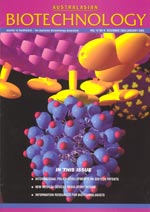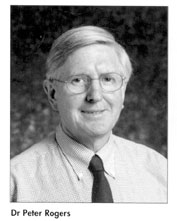
|
Australasian Biotechnology (backfiles)
AusBiotech
ISSN: 1036-7128
Vol. 10, Num. 1, 2000, pp. 2-3
|
Untitled Document

Australasian Biotechnology, Vol. 10 No. 1, 2000, pp. 2-3
FROM THE PRESIDENT
Peter Rogers, National President
Code Number: au00001
Towards
the end of last year I drove up to Queensland to spend Christmas with my family
on the North Coast. Driving provides plenty of time to see the rural economies
operating at first hand. The drive along the Newell Highway takes in the established
towns which provide a way of life that as a city dweller I can only yearn for,
especially around this time of the year when I am looking for a break. The big
towns don't seem to change much - except perhaps for the increase in the level
of road transport they service. But some of the smaller towns have changed -
some for the better and some for the worse.
On the NSW, Queensland border it appears that the good times have arrived.
The area is a centre of broad acre farming particularly for sorghum and for
cotton. But further north in the areas that have traditionally raised cattle
the outlook is not so good. The South Burnett Meat Works at Murgon for instance
in the Kingaroy district has closed. This company pioneered innovation in plant
and processing over the years and also instigated a state of the art tannery
in the district. The meatworks employed up to 500 people in its heyday a few
years ago. South Burnett also provided support for distance education and bioprocessing
ventures over the years.
I was pleased to see that the Prime Minister is touring country areas to see
things first hand and experience country issues. And also to appreciate the
opportunities for biotechnology and industry in the bush. I hope that he took
along some of the government's own information for background reading on the
journey: last year's inquiry into value adding Australian raw materials; including
the Chief Scientist's review into science capability; the inquiry into access
for primary producers to gene technology; and the public inquiry into access
to biological resources.
A recent article in Nature Biotechnology (Sagar A, Daemmrich A, Ashiya M,
18, 2-4, (2000)) caught my eye. Titled 'The tragedy of the commoners: biotechnology
and its public', the authors make the point that biotechnology seems unique
because it can both inspire acceptance as well as rejection simultaneously.
The National Farmers Federation accepts the power of the technology to develop
new desirable varieties of cereal crops but many of the rank and file will still
support GM's detractors. Sagar et al believe that rejection is triggered by
the possibility of centralisation and concentration of power in the hands of
a few. The issue of trust is obviously at the heart of acceptance. If biotechnology's
future does rely on governments and governing bodies listening and responding
to the public, the current exercise by the Prime Minister of touring the country
and responding to general concerns about exclusion from the boom times in the
city has to be a very positive move for the rational debate of GM issues.
Last year was something of a special year in terms of biotechnology coverage,
in the media, in the press, and as a recurring topic in government reviews.
This year will also produce a bumper crop of reviews. The Association will provide
input into these public debates on behalf of corporate and rank and file members,
and the Directors will appreciate receiving advice or input from members. The
submissions will be placed on the web site and some are also planned for publication
in the journal.
I hope that you enjoy the new Journal format. This is an exciting year. Plans
for the ABA2000 conference are well and truly down the track and if you are
driving to Queensland from down south, just remember be prepared to enjoy the
beautiful countryside.
Copyright 2000 - Australasian Biotechnology
| 